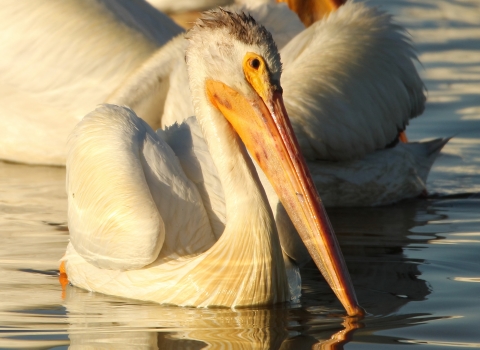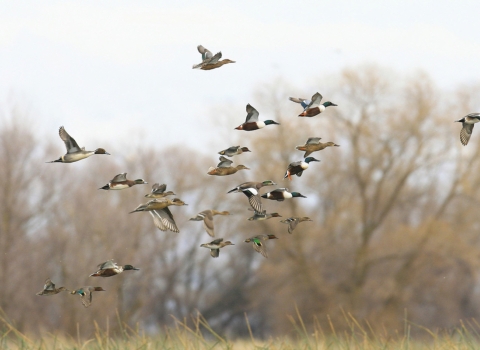The U.S. Fish and Wildlife Service today announced a proposal to reclassify the northern long-eared bat as endangered under the Endangered Species Act. The bat, currently listed as threatened, faces extinction due to the range-wide impacts of white-nose syndrome, a deadly disease affecting cave-dwelling bats across the continent.
Bats are critical to healthy, functioning ecosystems and contribute at least $3 billion annually to the U.S. agriculture economy through pest control and pollination. The growing extinction crisis highlights the importance of the ESA and efforts to conserve species before declines become irreversible.
“White-nose syndrome is devastating northern long-eared bats at unprecedented rates, as indicated by this science-based finding” said U.S. Fish and Wildlife Service Regional Director Charlie Wooley. “The Service is deeply committed to continuing our vital research with partners on reducing the impacts of white-nose syndrome, while working with diverse stakeholders to conserve the northern long-eared bat and reduce impacts to landowners.”
White-nose syndrome has spread across nearly 80% of the species’ entire range and nearly all of its U.S. range since it was listed as threatened in 2015. The proposal to change the status of the northern long-eared bat comes after an in-depth review of the species found that the bat continues to decline and now meets the definition of endangered under the ESA.
We have a strong foundation in place for working with stakeholders to conserve the bat while allowing economic activities within the range to continue to occur, and will continue to build on these in light of the northern long-eared bat’s endangered status. For example, the wind energy industry currently has 16 habitat conservation plans (HCPs) in place and an additional 13 in development. These HCPs allow wind energy projects to move forward after minimizing and mitigating their impacts to northern long-eared bats.
Many wind energy and transportation projects already have ESA compliance in place that will remain if reclassification to endangered status is finalized. For instance, the Service has completed a programmatic consultation with the Federal Highway Administration, the Federal Railroad Administration and the Federal Transit Administration that covers transportation projects throughout the entire range of the northern long-eared bat. As such, projects covered under this consultation and completed before the end of the year would not be impacted by the reclassification. We will continue to work with stakeholders to develop and provide additional opportunities for conservation of the northern-long eared bat. Learn more about HCPs and other ESA landowner tools.
The Service’s review found that white-nose syndrome is expected to affect 100% of the northern long-eared bat’s U.S. range by 2025, spreading more quickly than anticipated across the continent. Data indicate white-nose syndrome has caused estimated declines of 97 to 100% of affected northern long-eared bat populations.
Endangered species are those that are currently in danger of extinction, while threatened species are defined as likely to become endangered in the foreseeable future. The proposed reclassification, if finalized, would remove the current 4(d) rule as these rules may be applied only to threatened species. A 4(d) rule is one of the many tools of the ESA for protecting species listed as threatened. Typically, the Service uses 4(d) rules to incentivize positive conservation actions and streamline the regulatory process for minor impacts.
The northern long-eared bat is found in 37 states and the District of Columbia in the eastern and north central United States and all Canadian provinces from the Atlantic Coast west to the southern Northwest Territories and eastern British Columbia. These bats spend winter hibernating in caves and abandoned mines. During summer, the northern long-eared bat roosts alone or in small colonies underneath bark or in cavities or crevices of both live and dead trees. It emerges at dusk to fly primarily through the understory of forested areas, feeding mostly on moths, flies, leafhoppers, caddisflies and beetles.
To address the growing threat of white-nose syndrome to the northern long-eared bat and other bats across North America, the Service is leading the White-nose Syndrome National Response Team, a coordinated effort of more than 150 non-governmental organizations, institutions, Tribes, and state and federal agencies. Together we are conducting critical white-nose syndrome research and developing management strategies to minimize impacts of the disease and recover affected bat populations. To date, this effort has yielded scientific advancements that include identification of critical information about WNS and its impacts on North American bat species. We developed and are using disease surveillance tools to monitor spread and impacts, and we’re exploring promising biological, chemical, immunological, genetic and mechanical treatments.
The proposed rule to reclassify the northern long-eared bat as endangered appears in the March 23, 2022, Federal Register. Comments on the proposal may be submitted through May 23, 2022 by one the following methods:
- Electronically: Go to the Federal eRulemaking Portal: regulations.gov. In the Search box, enter the docket number or RIN for this rulemaking (presented above in the document headings). For best results, do not copy and paste either number; instead, type the docket number or RIN into the Search box using hyphens. Then, click on the Search button. On the resulting page, in the panel on the left side of the screen, under the Document Type heading, check the Proposed Rule box to locate this document. You may submit a comment by clicking on “Comment.”
- By hard copy: Submit by U.S. mail to: Public Comments Processing, Attn: FWS–R3–ES–2021–0140, U.S. Fish and Wildlife Service, MS: PRB/3W, 5275 Leesburg Pike, Falls Church, VA 22041–3803.
We request that you send comments only by the methods described above. We will post all comments on regulations.gov. This generally means that we will post any personal information you provide.
We will hold a virtual public informational meeting from 6:00 p.m. to 7:30 p.m., Central Time, followed by a public hearing from 7:30 p.m. to 8:30 p.m., Central Time, on April 7, 2022. To listen and view the meeting and hearing via Zoom, listen to the meeting and hearing by telephone, or provide oral public comments at the public hearing by Zoom or telephone, you must register. Register for the virtual public meeting and hearing. You may submit comments during the public hearing.
We will evaluate all information received during the comment period. We will announce our final decision in November 2022.





